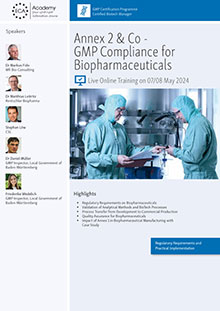WHO publishes Guideline on Worker Safety relating to Nanomaterials

Recommendation
7/8 May 2024
Regulatory Requirements and Practical Implementation
Relating to the fact that the importance of nanomaterials increases constantly - in pharmaceutical use as well as in other fields of research and industrial manufacturing - the WHO published a guideline document entitled "WHO guidelines on protecting workers from potential risks of manufactured nanomaterials (MNM)" end of 2017. This document pays attention to the small particle size of such materials which offers unique possibilities to develop better paints, better drugs and faster electronics. However, at the same time it bears new hazards for humans and the environment. Therefore, new risk assessments, new test methods and new regulatory standards are needed.
Currently, the knowledge and data base about human exposure pathways, impact of the human body and metabolism and possible biological effects is lacking or only fragmentary for many substances. And there are no long term side effects known either. But this can be reasoned by the short history of such products. Therefore the WHO states: "Health recommendations must, therefore, be based on extrapolation of the evidence from in vitro, animal or other studies from fields that involve exposure to nanoscale particles, such as air pollution, to the possible effects in humans. Workers in all countries will be at the front line of exposure to these materials, placing them at increased risk for potential adverse health effects."
The new WHO document should now support responsible professionals in the field of occupational health and safety with recommendations on staff safety and protection from possible hazards as well as to guide additional workers and employers.
The WHO defined the following topics as important issues and questions:
- Risks of MNMs
Which specific MNMs and groups of MNMs are most relevant with respect to reducing risks for workers and which should these guidelines now focus on, taking into account toxicological considerations and quantities produced and used. - Specific hazard classes
Which hazard class should be assigned to specific MNMs or groups of MNMs and how? - Forms and routes of exposure
For the specific MNMs and groups of MNMs identified, what are the forms and routes of
exposure that are of concern for worker protection? - Typical exposure situations
What are the typical exposure situations and industrial processes of concern for relevant specific MNMs or groups of MNMs? - Exposure measurement and assessment
How will exposure be assessed, and are there alternatives to current exposure assessment techniques for MNMs that should be recommended in LMI countries? - Occupational exposure limit (OEL) values
Which OEL or reference value should be used for specific MNMs or groups of MNMs? - Control banding
Can control banding be useful to ensure adequate controls for safe handling of MNMs? - Specific risk mitigation techniques
What risk mitigation techniques should be used for specific MNMs, or groups of MNMs in specific exposure situations, and what are the criteria for evaluating the effectiveness of controls? - Training for workers to prevent risks from exposure
What training should be provided to workers who are at risk from exposure to the specific MNMs or groups of MNMs? - Health surveillance to detect and prevent risks from exposure
What health surveillance approaches, if any, should be implemented for workers at risk from exposure to specific MNMs or groups of MNMs? - Involvement of workers and their representatives
How will workers and their representatives participate in the workplace risk assessment and management of handling MNMs?
For more information please read the complete "WHO guidelines on protecting workers from potential risks of manufactured nanomaterials".
In this context, please pay attention to ECAs, Loewe Center and Fraunhofer Institutes joint conference on "Nano and Micro Formulations" on 13/14 Marche 2018 in Berlin.
Related GMP News
GMP Conferences by Topics
- General Quality Assurance and GMP Compliance Topics
- Hygiene
- General Microbiology Topics
- Regulatory Affairs
- Development
- General Analytics Topics
- Good Distribution Practice
- Sterile Manufacturing
- Computer Validation
- General Qualification/Validation Topics
- General Engineering Topics
- APIs/Excipients
- GMP Basic Training Courses
- Medical Devices and Combination Products
- Packaging and Packaging Material
- Data Integrity
- Qualified Person (QP)
- GMP Auditing
- Documentation
- Cleaning Validation
- General IT Compliance Topics
- Impurities
- OOS / OOE / OOT
- Material Testing
- Validation of Analytical Methods
- Analytical Instrument Qualification
- Stability Testing
- Microbiological Testing
- Technology
- General Manufacturing Topics
- Solid Dosage Forms/Semi-Solid Dosage Forms
- Biotechnology/Blood/ATMP
- Herbal Drug Products/Cannabis/Radiopharmaceuticals
- Others




